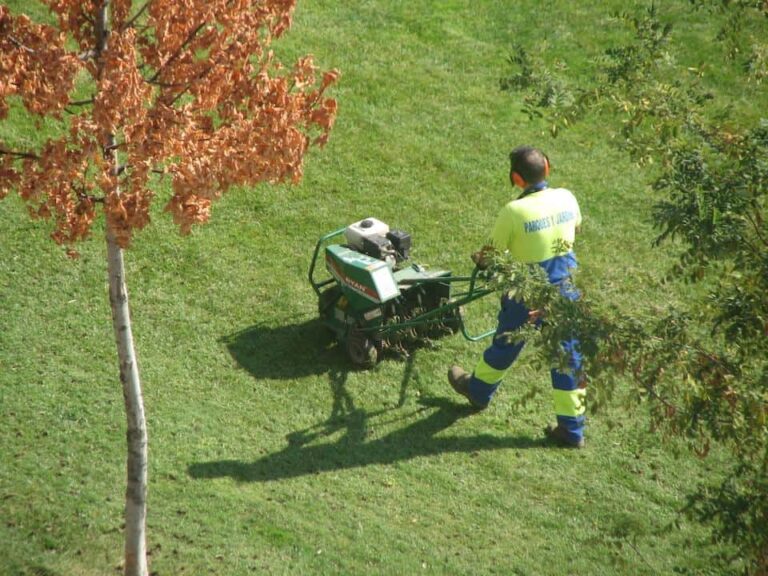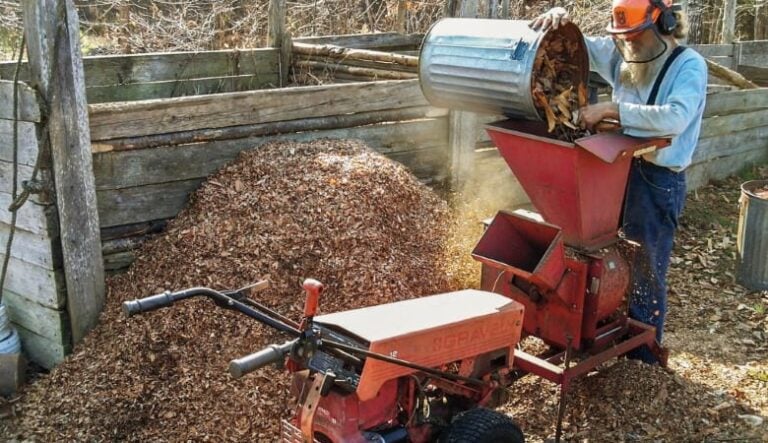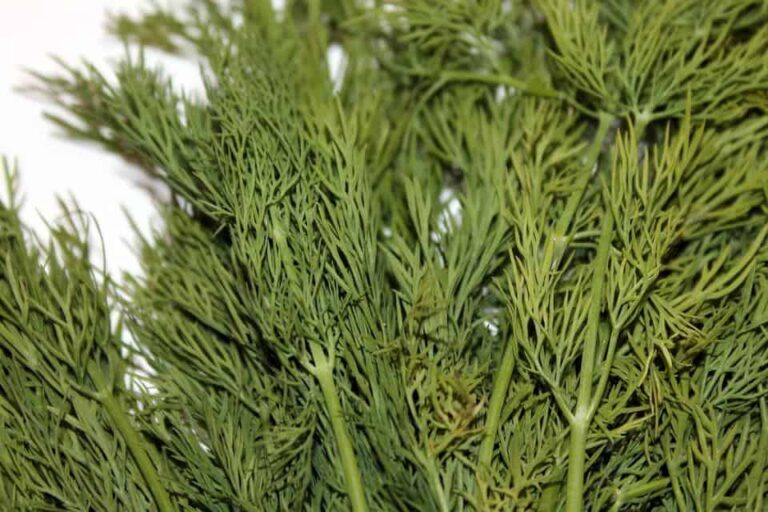Pothos Leaves Turning Yellow: Why, and How to Fix Them
Pothos (Epipremnum aureum) is also known as Golden Pothos, Devil’s Vine and Devil’s Ivy. A trailing vine, native to the Solomon Islands, it has pointed, heart-shaped green leaves that are sometimes variegated with white, yellow, or pale green striations.
Some types of Pothos, like the Marble Queen Pothos, have yellow speckled details in their leaves.
If those beautiful leaves start to turn yellow, and it’s not part of the plant’s natural appearance or aging process, then it could be a sign that something is wrong. Intense and worsening yellowing of the leaves is a cry for help from your Pothos plant.
You need to find out why the leaves are turning yellow by finding the source of the problem. Then you need to resolve the problem and save your Pothos.
Aging
Older leaves turn yellow and die off as a natural part of the Pothos plant’s aging process.
If there’s new foliage, the yellowing leaves are older and at the bottom of the plant, and only one or two leaves are turning yellow at a time, it’s likely natural. This is obviously a relief.
How To Resolve The Problem
If the yellowing leaves are coming to the end of their natural life span, then it’s a case of observing your plant to ensure the yellowing isn’t a sign of another problem. You could apply a diluted houseplant fertilizer to boost the nutrients of the soil.
If the leaves are yellowing because of age, you could leave them on the plant until they are fully yellow all the way through.
This gives the plant a chance to recover some of the nitrogen, phosphorus, potassium, and other essential nutrients from the leaves (source).
Overwatering
If the yellow leaves on your Pothos are also wilting or starting to show brown spots, your Pothos may be overwatered. Improper soil moisture, usually due to overwatering, can cause Pothos leaves to turn yellow.
Too much water can be inter-connected with not enough light because, when the plant doesn’t get enough light, it doesn’t use up enough water. When there’s too much water the roots don’t receive enough air and drown and rot.
The leaves will turn plump and yellow when there’s too much water. If the saucer, in which your Pothos plant sits, overflows when you water then you’re overwatering.
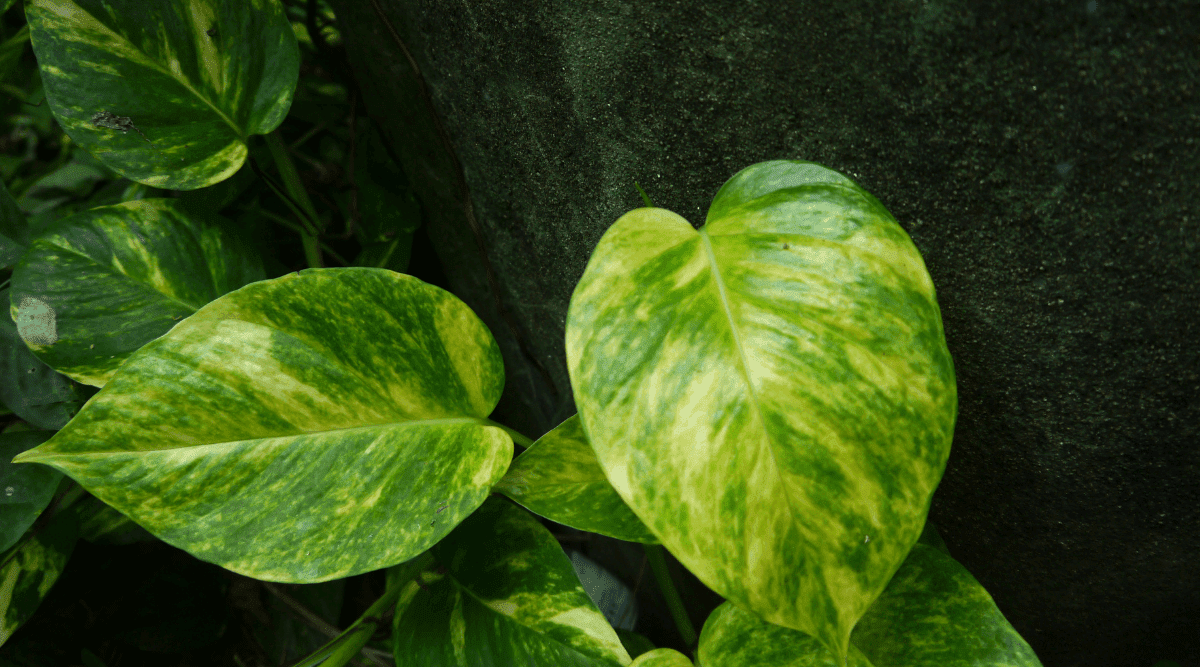
How To Resolve The Problem
Move your Pothos to a sunnier spot. It may be that the soil is taking too long to dry out. Moving your plant closer to a window can also help because more sunlight means more energy for processing water.
Correct for poor drainage. Ensure that the pot has a drainage hole. If the soil drains slowly or holds on to moisture, mix in some perlite, coco coir, or coarse sand.
Scale back watering. Wait to water when the soil is dry and the stems are looking droopy. Only water Pothos when the top quarter of the soil in the pot is dry. Soil should remain damp, but not wet or soggy.
In the winter, allow the plant to dry out a little between waterings, but boost the humidity around your plant with regular misting, a humidifier, or pebble tray. Provide enough water so that liquid flows from the drainage hole at the bottom of the pot and into the saucer.
Discard any excess water in the saucer.
Do not alternate between over and under watering.
If the leaves are yellowing because of improper watering you could leave them on the plant until they are fully yellow all the way through, to give the plant a chance to recover some of the nitrogen, phosphorus, potassium, and other essential nutrients from the leaves (source). However, you can also just clip the yellow leaves off.
Underwatering
The general advice for Pothos is to water when the soil is dry. When your Pothos needs water, the vines and leaves will look droopy, a bit limp, and curl inward. If the yellow leaves are also looking crispy, your Pothos may be under-watered.
How To Resolve The Problem
Watch for early signs that your Pothos is getting thirsty. Press your finger into the soil. If it feels dry the plant is probably thirsty. If the vines look droopy instead of bouncy it’s time to water them.
Aerate the soil. Gently poke the soil, with something like a skewer, being careful not to damage the roots. Air can now get in and water circulates all around the roots.
Slowly pour room temperature water all around the surface of the soil, until you see water running out of the drainage hole.
Return your Pothos to a spot where it gets plenty of light. Make sure the pot has good drainage and the potting medium is well-draining.
A good soak may help once a month. Fill a sink with 2 to 4 inches of water, depending on the size of your plant. Let your plant sit in the water for at least 30 minutes, soaking up the liquid from the bottom.
Lift the plant and feel if its pot is heavier. Drain the sink and let the plant rest, allowing excess water to trickle out from its drainage hole. Place the plant back on its saucer. If the saucer immediately fills with water, allow your plant to drain for a little longer so it’s not in danger of root rot.
If the leaves are yellowing because of improper watering, you could leave the yellowing leaves long enough for the plant to recover some of the nitrogen, phosphorus, potassium, and other essential nutrients from the leaves (source).
Inconsistent Watering
Pothos leaves turning yellow is a sign that the plant is experiencing some sort of stress, and it could be inconsistent watering. If the soil is regularly alternating between too dry and oversaturated, this causes stress exhibited in yellow leaves.
How To Resolve The Problem
Become more in tune with the needs of your plant. Check your plant’s soil is aerated and that the drainage hole is working. Feel the soil to detect whether it has enough or too much water. Get into a watering routine and always take into account changes in light and season. Less light can mean less water take up.
If the leaves are yellowing because of improper watering, you could leave the yellowing leaves long enough for the plant to recover some of the nitrogen, phosphorus, potassium, and other essential nutrients from the leaves (source).
Humidity
Low humidity and dry soil will cause leaves to droop and brown on the edges, followed by yellowing, browning, and leaf drop.
How To Resolve The Problem
Regularly mist your plant’s leaves. A humidifier or pebble tray can also be of benefit.
Too Little Light
Pothos need bright to medium indirect sunlight, but adapt to lower light. In very low light, yellow leaves may develop. Don’t place it in full sunlight, as the foliage will burn.
According to Alexi Coffey, the co-founder of Steward, a phone app about plant care, lack of light means the plant’s water uptake is compromised and it can end up suffering overwatering; even if you aren’t actually giving it more water than when the light was better.
When Pothos plants aren’t getting enough light, some of the green leaves start to turn yellow and look plump. Foliage on the top and bottom of the plant might especially do so but it could be random.
How To Resolve The Problem
To resolve the problem if your Pothos is not getting enough light, try moving it closer to a window. After a week or two in this new location, you should start to notice less new yellowing.
Too Much Light
Pothos plants that are receiving too much light may also grow yellow leaves. The leaves droop and look a little crispy.
How To Resolve The Problem
If your Pothos is getting too much light move it to a spot with lower light.
Pests
A weakened or stressed Pothos is more susceptible to insect infestations. Spider mites can drain moisture, causing yellowing of leaves. Scale, mealybugs, and spider mites are a real problem for indoor plants.
Mealybugs appear as white fuzzy spots in folds, crannies and hollows of the plant.
Spider mites look like tiny spiders, detected by the white webbing they leave behind.
How To Resolve The Problem
Isolate the Pothos from other plants.
Remove mealybugs with a cotton swab dipped in rubbing alcohol.
Spray down the plant with water to knock off the mites.
Treat with an insecticidal soap or neem oil.
Mineral Deficiency
Insufficient nitrogen, phosphorus, iron, and potassium can cause yellow spotting.
The pattern of your plant’s yellowing can indicate what mineral deficiency is going on.
Yellowing at the edges, but green in the middle, suggests low magnesium.
If a leaf’s veins and stems look green but the rest of the leaf has turned yellow, it could suggest iron, zinc, or manganese deficiencies.
If the leaves at the bottom of your plant are turning yellow, it points to a nitrogen deficiency.
If the top leaves are turning yellow, too little sulfur may be the issue.
How To Resolve The Problem
If there’s a nutrient deficiency to blame, give your Pothos some fertilizer. This plant food guide can help. Most plants benefit from fertilizing a couple of times a year in the spring and summer. Pothos likes fertilizers containing iron. Epsom salts can add a hint of magnesium.
If the leaves are yellowing because of mineral deficiency, you could leave the yellowing leaves long enough for the plant to recover some of the nitrogen, phosphorus, potassium, and other essential nutrients from the leaves (source).
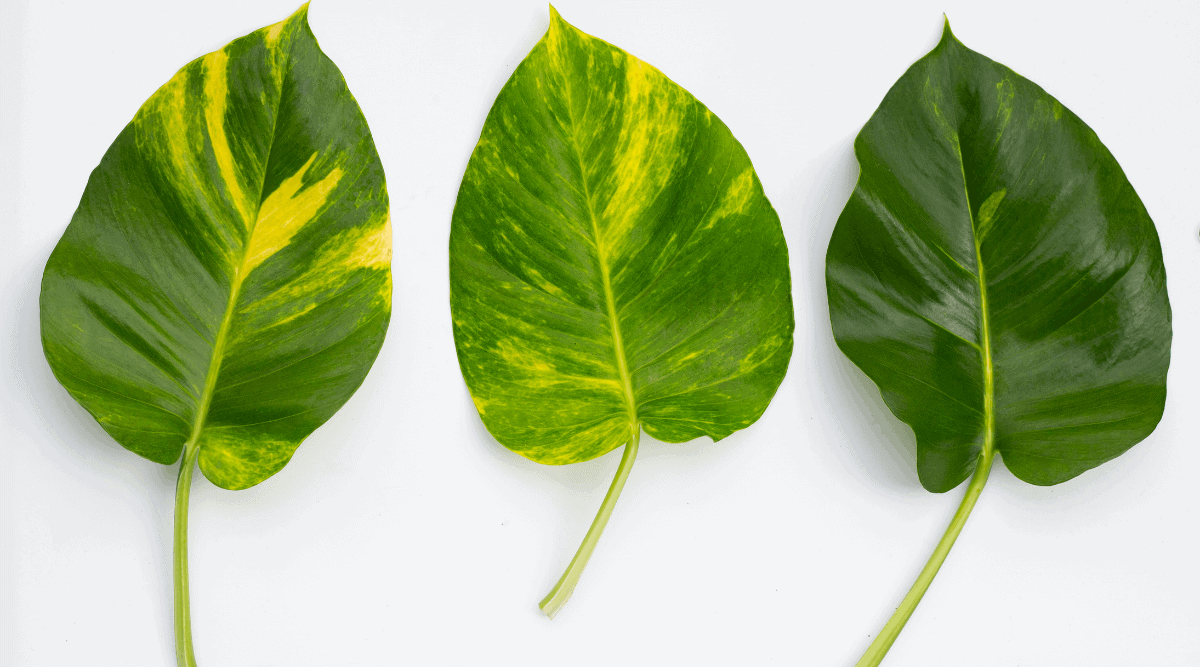
Mineral Overload
Tap water is high in fluoride, salts, or chlorine and can cause nutrient build-up on leaves over time.
Mineral overload causes scorched leaves with yellow and brown burns.
How To Resolve The Problem
If leaves are scorched because of tap water then water your plant with water left uncovered overnight so the minerals evaporate, with distilled water, or with rainwater you collect.
Root Bound
If the Pothos has outgrown its planter and become root bound, this can lead to leaves turning yellow. If you can see its roots poking out the drainage holes then your plant has become root bound. Slowed or stunted growth is another sign that your plant is root bound. If the plant seems to be running out of space, again this suggests that your plant is root bound.
How To Resolve The Problem
In any and all of the root bound situations the plant needs to be repotted.
Gently tip the Pothos out of its pot, supporting the bottom of the plant with your hand.
Look at the root ball. If the roots are dense and wrapped in the shape of the pot, it’s time for repotting.
Re-pot your Pothos.
Root Rot
This is caused by pathogens like pythium or fusarium, which thrive in waterlogged soil. If lots of leaves turn yellow and the stems are mushy, inspect the roots. If the roots are mushy, soft, and black, your plant is suffering root rot.
How To Resolve The Problem
If any of the roots still appear pale and firm, gently rinse the roots under lukewarm water, removing as much soil as possible.
Use a sharp pair of shears to remove all of the rotted roots.
Get rid of the old potting soil.
Wash the pot with a diluted bleach solution to kill any remaining pathogens.
Repot the Pothos in fresh, well-draining potting mix. You may need to size down the pot if lots of roots have been lost. Dip the roots in a fungicide before replanting.
Clean the shears with rubbing alcohol and prune back any affected leaves. Also prune additional leaves proportional to the roots you cut back. This ensures that the healthy roots won’t be overly worked trying to support so many extra leaves.
Bacterial Leaf Spot
If the yellowing appears as halos around soft, watery, mushy spots on the leaves, it may be bacterial leaf spot.
How To Resolve The Problem
Remove the infected leaves and petioles, the parts that connect leaves to the stems.
Treat with a bactericide.
Ensure you pour water directly on the soil, rather than getting the leaves wet.
Conclusion
Pothos is considered to be a resilient plant that can cope well with low light. Many people beginning to own plants will get a Pothos because it’s got a hardy reputation.
Yet it’s crucial to remember that it’s a living being and, like all plants, you cannot take it for granted. All plants need light, water, minerals and aerated soil.
Plants need consistency in their care and an observant eye over their welfare.
One way that plants let you know they are having problems is through their appearance. The leaves of a plant are a good indicator of plant health.
There could be all sorts of reasons as to why your Pothos plant starts getting yellow leaves.
You need to determine if it’s natural aging or a sign of a problem. If it’s a problem, determine the cause and then do everything you can to resolve the issue and get your beautiful Pothos back to blooming good health.
Further Reading
https://www.mindbodygreen.com/articles/pothos-leaves-turning-yellow
https://growfully.com/pothos-leaves-turning-yellow/
https://www.thespruce.com/pothos-an-easy-to-grow-houseplant-1403154


